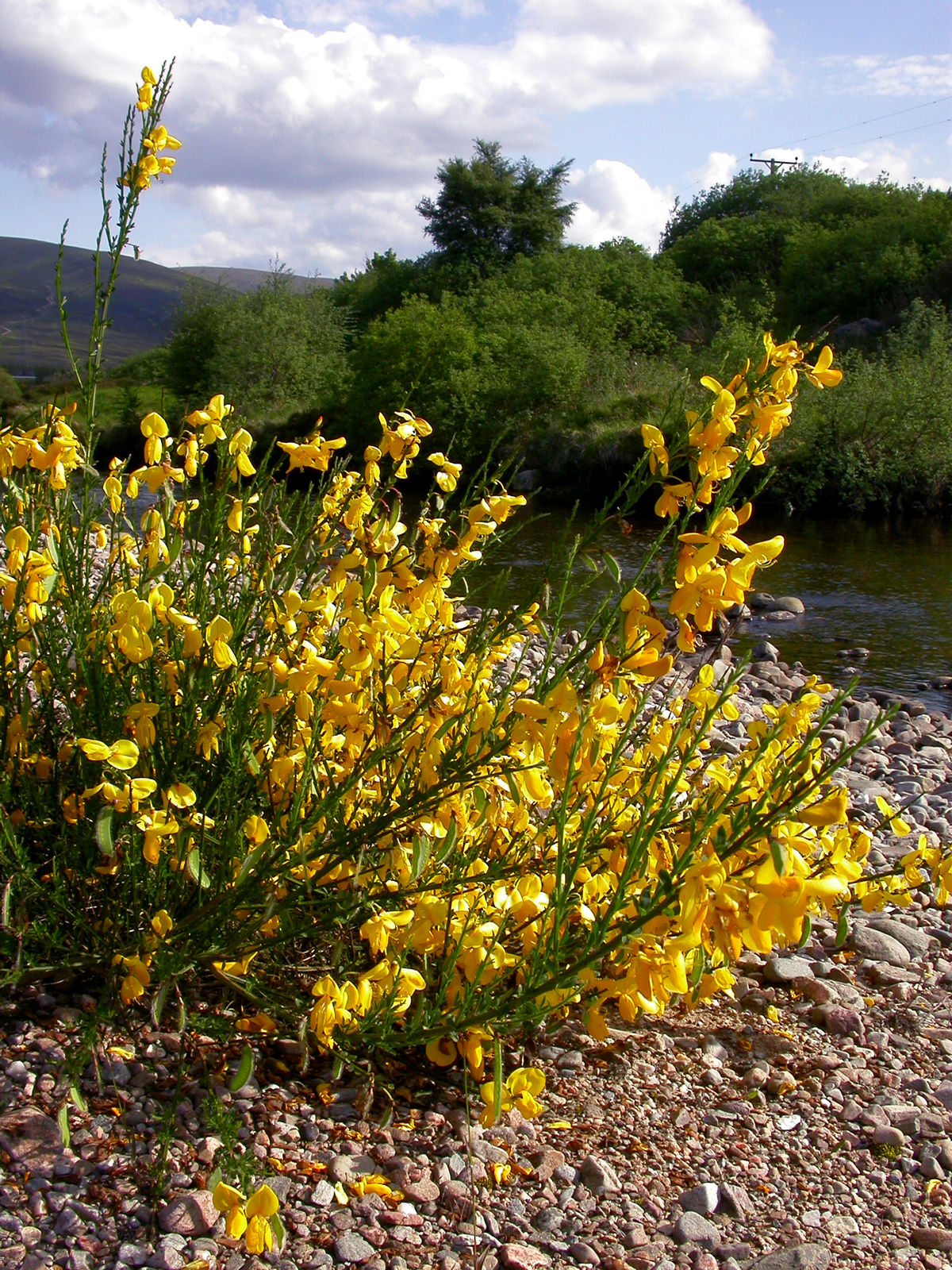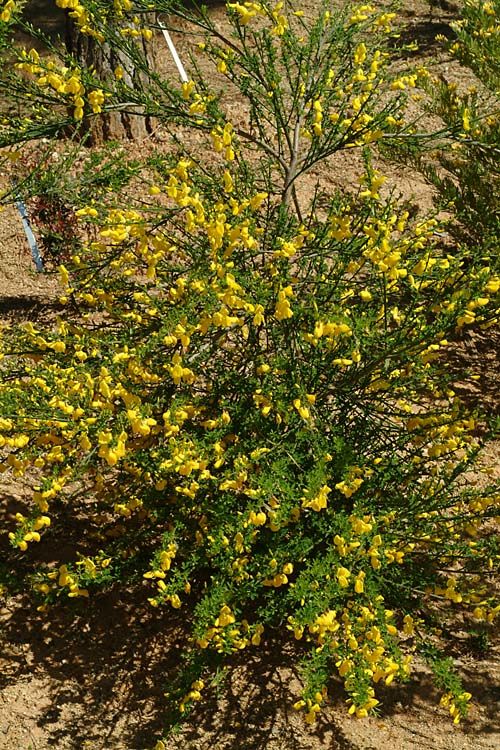Scotch broom
cytisus scoparius
Also known as: ["Scotch broom","Broom","English broom","Scotch gorse"]
Overview
A deciduous shrub native to Western Europe, known for its bright yellow flowers and slender green stems.
Benefits & Perks
["drought tolerant","wildlife attractant (bees, butterflies, birds)","low maintenance"]
Botanical Classification
| Phylum: | Magnoliophyta |
| Class: | Magnoliopsida |
| Order: | Fabales |
| Family: | Fabaceae |
| Genus: | Cytisus |
| Botanical Name: | Cytisus scoparius |
Plant Characteristics
Basic Information
- Category: Shrubs
- Suitable Location: outdoor garden bed in a sunny, open area
- Suitable For:
- Is Weed: No
- Allergenicity: moderate
Environmental Needs
- Climate: {"temperatureRange":"5–30°C"}
- Hardiness: {"zones":"6–9"}
- Misting: rarely required
- Drainage: Fast-draining. Poor drainage can lead to root rot.
- Soil Type: Well-draining, sandy, or loamy soil with low fertility. Tolerates poor soils.
Maintenance Level
- Maintenance Level: low
- Toughness Level: high
- Pruning Frequency: Annually, after flowering in late spring or early summer.
- Pruning Intensity: Moderate. Remove up to one-third of old growth to rejuvenate the plant.
Care Details
Ideal Sunlight Coverage:
Full sun (6–8 hours of direct sunlight daily). Tolerates partial shade but may become leggy.
Sunlight Tolerance Tips:
Acclimate plants gradually if moving from shade to sun. Protect from intense midday sun in hot climates. Ensure good air circulation to prevent fungal issues.
Care Requirements
Care Difficulty
moderatemoderate
Sunlight
full sun
Full sun is essential; avoid deep shade; rotate pots for even growth.
Watering
every 7–10 days during active growth, less frequently in winter
Water thoroughly but infrequently; allow soil to dry between waterings; avoid overwatering to prevent root rot.
Soil
well-drained, sandy or loamy soil
pH: Slightly acidic to neutral (pH 6.0–7.0).
Ensure excellent drainage; avoid heavy clay soils; mulch to retain moisture.
Temperature
Hardy in USDA zones 6–8. Prefers cool to moderate temperatures (50–75°F or 10–24°C).
Protect from extreme cold; water less in winter; provide shade in intense heat.
Fertilizing
every 2–3 months during spring and summer
Fertilize sparingly; avoid nitrogen-heavy formulas; apply before active growth begins.
Propagation
Methods
Softwood or semi-hardwood cuttings taken in summer. Layering is also effective.
Step-by-Step Propagation Guide
- Take 4–6 inch cuttings.
- Remove lower leaves.
- Dip in rooting hormone.
- Plant in medium.
- Maintain humidity.
Best Time: Late spring to early summer when new growth is firm but not woody.
Environment
Warm (65–75°F or 18–24°C), humid environment with indirect light.
Medium
Well-draining mix of peat and perlite or cactus mix.
Hormone
Rooting hormone is recommended to improve success rates.
Timeline
Roots typically form in 4–8 weeks. Plants may take a full growing season to establish.
Tools Needed
Pruning shears, rooting hormone, propagation tray, misting spray bottle.
Quick Tips
Use fresh cuttings; maintain humidity; avoid direct sun during rooting.
Pruning & Repotting
Pruning Guide
Method
Cut back stems to healthy buds or lateral branches. Remove crossing or crowded branches.
Pruning Plan
Prune to maintain shape, encourage bushiness, and remove old or dead wood. Pruning also promotes better flowering.
Tools
Pruning shears, loppers (for larger stems), sterilizing solution.
Checklist
Sterilize tools; prune after flowering; remove dead/diseased wood; shape the plant.
Repotting Guide
Best Season
Early spring before new growth begins.
Pot Size
Move to a pot one size larger (2–3 inches wider in diameter).
Method
Use fresh, well-draining soil. Gently tease out crowded roots. Ensure the new pot has drainage holes.
Suggestions
Generally not required unless grown in containers. Repot every 2–3 years or when roots fill the pot.
Checklist
Prepare new pot; trim roots if needed; use fresh soil; water lightly after repotting.
Advanced Care Tips
Watering Mastery
Watering Checklist
Check soil moisture before watering; water deeply; ensure drainage; adjust for season.
How to Apply Water Properly
Water at the base of the plant, ensuring moisture reaches the root zone. Water early in the morning to minimize evaporation and fungal issues. Ensure excess water drains away to prevent waterlogging.
Watering Schedule Tips
Water deeply once every 1–2 weeks during active growth, reducing frequency to once a month in winter. Adjust based on rainfall and soil dryness.
Soil Improvement
Add sand or perlite to improve drainage. Incorporate compost for organic matter if needed.
Temperature Stress Management
Signs of Temperature Issues
Chlorosis, leaf drop, or stunted growth in extreme heat or cold. Wilting or browning in excessive heat.
Cold Stress
Can tolerate frosts but prolonged freezing may damage tender growth. Cold, wet soil increases root rot risk.
Solution: Mulch heavily in winter to insulate roots. Avoid overwatering in cold weather. Protect from harsh winds.
Hot Stress
Excessive heat can cause wilting, leaf scorch, or reduced flowering. Drought stress may lead to leaf drop.
Solution: Provide afternoon shade in hot climates. Water deeply during heatwaves. Apply mulch to retain soil moisture.
Fertilizing Guide
Fertilizing Checklist
Use balanced fertilizer; apply in spring; avoid late-season feeding.
Fertilizing Method
Use a balanced, slow-release fertilizer in early spring. Avoid high-nitrogen fertilizers, which can reduce flowering. Reduce or stop fertilizing in late summer/autumn.
Common Problems & Solutions
Toxicity Warning
Cats
ToxicCats are highly sensitive to the quinolizidine alkaloids in Cytisus scoparius, which can cause severe gastrointestinal, neurological, and cardiovascular disturbances. The toxic compounds interfere with neurotransmitter function and can lead to life-threatening conditions if not addressed promptly.
⚠️ Symptoms:
🌿 Toxic Parts:
⚡ Toxic If:
if eaten
Dogs
ToxicIn dogs, ingestion of Cytisus scoparius can lead to gastrointestinal upset, neuromuscular effects, and potentially severe cardiac or respiratory complications due to the presence of quinolizidine alkaloids. These compounds disrupt normal physiological processes, particularly affecting the nervous and cardiovascular systems.
⚠️ Symptoms:
🌿 Toxic Parts:
⚡ Toxic If:
if eaten
Humans
ToxicCytisus scoparius contains quinolizidine alkaloids, primarily sparteine, which can cause significant physiological effects including neuromuscular blockade, cardiac arrhythmias, and central nervous system depression. These compounds interfere with acetylcholine receptors and affect ion channel function, leading to systemic toxicity.
⚠️ Symptoms:
🌿 Toxic Parts:
⚡ Toxic If:
if eaten
Frequently Asked Questions
Q: Is Scotch broom toxic to pets?
A: Yes, it is toxic to dogs and cats if ingested.
Q: Does Scotch broom attract wildlife?
A: Yes, it attracts bees, butterflies, and birds.
Q: Is Scotch broom considered a weed?
A: Yes, it is often classified as an invasive weed in many regions.
Quick Reference
| Family: | Fabaceae |
| Care: | moderate |
| Light: | full sun |
| Water: | every 7–10 days during activ |
Get Expert Care Tips
Download the Plantious app for personalized care reminders and plant identification!
Google Play App Store








